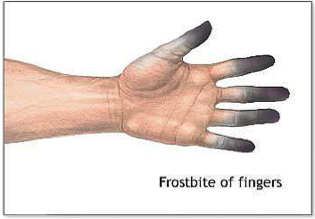Written By: Camelia Amiri, Student-at-Law
With extreme cold weather coming our way, Canadians are reminded to take extra steps in order to avoid cold-weather emergencies, such as frostbite and hypothermia. According to the Canadian Centre for Occupational Health and Safety, toes, fingers, ears, and the nose are at the greatest risk of being affected by the cold. These areas of the body do not have major muscles to produce heat, and the body preserves heat by favouring the internal organs and reducing blood flow to extremities under cold conditions. Given the risk of injury posed by the cold winter, it is important to prevent these cold-related emergencies, be able to recognize when someone has been exposed to the cold for too long, and provide help when needed.

Preventative Steps
The easiest preventative step to take is to dress with the weather in mind and to cover up exposed body parts as much as possible. Hats, gloves, and layers of tightly woven fabrics such as wool or synthetics are recommended by the Canadian Red Cross. Drinking plenty of warm fluids, while avoiding caffeine and alcohol, is also recommended to help the body stay warm.
Recognizing Cold-Related Emergencies
Frostbite
Frostbite is a condition in which body tissues freeze. It happens most often in the body’s extremities (e.g. fingers, toes, ears, etc.). Blood vessels may be severely and permanently damaged, and blood circulation may stop in the affected tissue. Frostbitten skin often first appears paler than usual, but can progress to have a white waxy appearance, and progress even further to have a dark blueish appearance (see photo below).
Hypothermia
When a person is exposed to cold temperatures for a prolonged period of time, the body is unable to compensate for heat loss. This causes the body’s temperature to decrease. The sensation of cold followed by pain in exposed parts of the body is one of the first signs of mild hypothermia. As the temperature continues to drop or as the exposure time to the cold increases, sensations of cold and pain start to diminish, and numbness starts to kick in.Muscular weakness and drowsiness are experienced next. This condition is usually referred to as moderate to severe hypothermia and usually occurs when body temperature falls below 33°C. Other symptoms include interruption of shivering, diminished consciousness, and dilated pupils. When the body’s temperature reaches 27°C, a coma is likely to occur and a pulse may not be noticeable.Heart activity stops at around 20°C and the brain stops functioning around 17°C.
Steps to Take in the Event of a Cold-Related Emergency
What to do if someone has frostbite
Seek medical attention as soon as possible. Cover and bandage the affected area with a dry sterile dressing while keeping the person warm. Never rub the skin or apply dry heat in an attempt to warm the area as this can cause permanent damage to the tissue. Active re-warming by immersing the affected area in warm water should only be done if access to a medical facility is not possible.
What to do if someone is suffering from hypothermia
Seek medical attention immediately. If possible, get the person away from the cold and into shelter. Remove any wet clothing that the person may be wearing and gently dry the person. Warm the person up with blankets, and if the person is alert, provide them with hot liquids (non-alcoholic and non-caffeinated).
There are obviously many benefits to staying active and spending time outside during the winter months. Remembering to take precautions to avoid cold-related emergencies and knowing what to do in the event of one will make the winter months a more enjoyable, stress-free experience.






